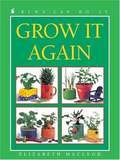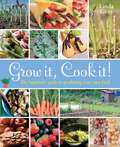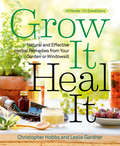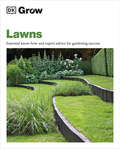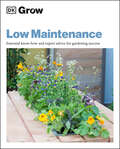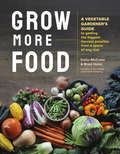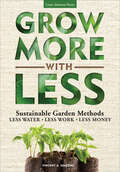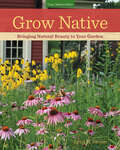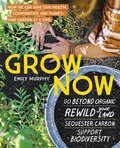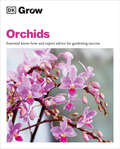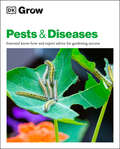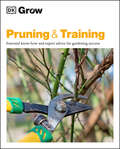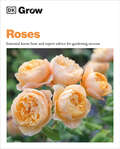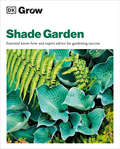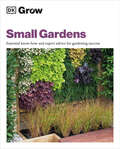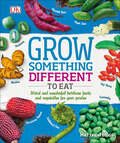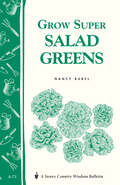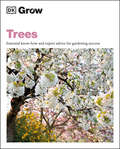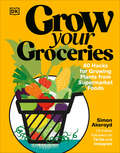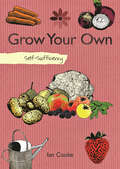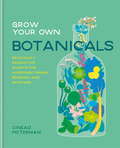- Table View
- List View
Grow It Again
by Elizabeth MacleodA great gardening book for kids! Don't throw out those carrot tops and apple cores--grow them instead! Bring your avocado pit and garlic bulbs back to life by growing them again. Turn a snap pea into a vine, an orange into a tree and much more! You can create a garden from last night's dinner, make easy recipes, and decorate your own colorful pots and planters. YOU CAN MAKE milk-carton planters pressed flowers dish gardens desserts and treats seed jewelry painted flowerpots Illustrated step-by-step instructions make it easy
Grow It, Cook It!: The Beginner's Guide To Producing Your Own Food
by Linda GrayMany crops, including herbs, can be produced in a relatively small space with a little pre-planning and organizing: in containers, on a balcony, and indoors. Herbs are perfect for enhancing the flavour of cooking, treating minor ailments, and preventing colds and flu. Your own back garden will not only produce the best food on the planet for you and your loved ones, it is also economical, environmentally friendly and more fun than shopping. Gardening is more than a hobby; it's a way of life. This book provides all the information you need to keep your family and friends healthy, fit and enjoying life to the full.
Grow It, Cook It!: The Beginner's Guide to Producing Your Own Food
by Linda GrayMany crops, including herbs, can be produced in a relatively small space with a little pre-planning and organizing: in containers, on a balcony, and indoors. Herbs are perfect for enhancing the flavour of cooking, treating minor ailments, and preventing colds and flu. Your own back garden will not only produce the best food on the planet for you and your loved ones, it is also economical, environmentally friendly and more fun than shopping. Gardening is more than a hobby; it's a way of life. This book provides all the information you need to keep your family and friends healthy, fit and enjoying life to the full.
Grow It, Heal It: Natural and Effective Herbal Remedies from Your Garden or Windowsill
by Christopher Hobbs Leslie GardnerWhere there's a symptom, there's also a homegrown cure. With just a windowsill, container, or small space, it's easy to grow an instant herbal remedy. Whether it's a cough, heartburn, joint pain, or neuralgia, readers will discover how easy it is to treat 40 ailments and conditions using herbs and herbal preparations they grow and make themselves. With inspiration found in science, tradition, and modern herbalistic practices, Grow It, Heal It touts the healing power of more than 50 herbs—from anise hyssop to yerba mansa. Two of the nation's premiere herbalists share growing, harvesting, and healing advice in this easy-to-use and friendly guidebook for herbal newbies, featuring teas, tinctures, salves, poultices, compresses, and aromatherapy. Among the many benefits of growing do-it-yourself remedies, readers will discover the convenience of preparing healing potions and salves when they're most needed; the advantage of having organic, fresh, and high-quality herbs they've nurtured themselves; and how empowering it is to engage in self-care and why that's important to the healing process. Growing herbs at home allows readers to take an active role in their own health care.
Grow Lawns: Essential Know-how and Expert Advice for Gardening Success (DK Grow)
by DKCreate the ideal lawn for your space and know how to look after it with Grow Lawns.Ideal for first-time gardeners, Grow Lawns contains everything you need to know to choose and maintain the perfect lawn - whether that means formal straight lines, a playful space, or a hub for wildlife. Understand different grass types, whether to sow seed or lay turf, and maintenance techniques, including mowing, aerating, and scarifying. Discover alternatives, too, such as bulbs to add color in spring or wildflower meadows to attract pollinators. Find useful tips and tricks to help with your lawn maintenance.Whether you are an avid gardener or want to create an easy-to-maintain garden, this book can guide you and answer important questions like How does your garden lawn grow? What do you want from your lawn? Should I use turf or seed and more.With this book, you can find:-Fuss-free guide to designing, creating, and maintaining a lawn, ideal for first-time gardeners-Explores a range of different needs and basic techniques so beginners know where to start with different kinds of grass/lawns-Helpful tips on how to care for your lawn to maintain it for longer- including Essential tools, types of mowers, watering, feeding your lawn, and more-Images and descriptions of issues that your lawn may face, such as pests, weeds, and conditions, and ways you can solve thisPacked with practical, jargon-free know-how, this easy-to-use guide has everything you need to know to help your garden Grow. This useful guide contains images, facts, and information to help you grow a lawn that suits your lifestyle. Grow Lawns is part of a series with GROW Houseplants, GROW Compost, GROW Herbs, and GROW Trees.
Grow Low Maintenance: Essential Know-how And Expert Advice For Gardening Success (DK Grow)
by Zia AllawayDesigning, creating, and maintaining a beautiful garden doesn&’t have to be time-consuming. Ideal for first-time gardeners, Grow Low-Maintenance contains everything you need to create a low-fuss garden without compromising on design or beauty. Ideal for gardeners who are short on time and need to keep things simple, this book shows you which plants require little to no regular maintenance, and features plenty of tips and tricks to keep your garden in top shape with minimal effort, including ways to minimize watering, make the most of vertical space, and reduce the need to weedPacked with practical, jargon-free know-how, this easy-to-use guide has everything you need to know to help your garden Grow.
Grow Marijuana Now!
by Alicia WilliamsonThe only thing better than growing marijuana is growing it fast. This lucrative cash crop is in great demand for its medicinal and recreational benefits--and with this easy-to-understand primer, you can realize profits from pot in less time than it takes to grow tomatoes. You can manufacture the greatest and grandest ganja when you learn how to:Grow top crops indoors or outGerminate seeds in as few as 24 hoursRotate vegetative and flowering cyclesCreate, fertilize, and de-pest the best soil mixturesHarvest and cure plants for saleWith this book as your guide, you will grow a great business in no time--literally!
Grow Marijuana Now!: An Introductory, Step-by-Step Guide to Growing Cannabis
by Alicia WilliamsonThe only thing better than growing marijuana is growing it fast. This lucrative cash crop is in great demand for its medicinal and recreational benefits-and with this easy-to-understand primer, you can realize profits from pot in less time than it takes to grow tomatoes. You can manufacture the greatest and grandest ganja when you learn how to:Grow top crops indoors or outGerminate seeds in as few as 24 hoursRotate vegetative and flowering cyclesCreate, fertilize, and de-pest the best soil mixturesHarvest and cure plants for sale With this book as your guide, you will grow a great business in no time-literally!
Grow More Food: A Vegetable Gardener's Guide to Getting the Biggest Harvest Possible from a Space of Any Size
by Colin McCrate Brad HalmJust how productive can one small vegetable garden be? More productive than one might think! Colin McCrate and Brad Halm, former CSA growers and current owners of the Seattle Urban Farm Company, help readers boost their garden productivity by teaching them how to plan carefully, maximize production in every bed, get the most out of every plant, scale up systems to maximize efficiency, and expand the harvest season with succession planting, intercropping, and season extension. Along with chapters devoted to the Five Tenets of a Productive Gardener (Plan Well to Get the Most from Your Garden; Maximize Production in Each Bed; Get the Most out of Every Plant; Scale up Tools and Systems for Efficiency; and Expand and Extend the Harvest), the book contains interactive tools that home gardeners can use to assist them in determining how, when, and what to plant; evaluating crop health; and planning and storing the harvest. For today&’s vegetable gardeners who want to grow as much of their own food as possible, this guide offers expert advice and strategies for cultivating a garden that supplies what they need. This publication conforms to the EPUB Accessibility specification at WCAG 2.0 Level AA.
Grow More with Less: Sustainable Garden Methods
by Vincent A. SimeoneHorticultural expert Vincent Simeone helps you plan your green garden in this practical, holistic guide. With detailed, strategic timelines for both short-term and long-term gardening techniques, Grow More with Less lets you put your best foot forward in creating an efficient, sustainable home landscape. From composting and mulching to planting trees, author Vincent Simeone covers all the eco-friendly essentials in one straightforward handbook. Simeone makes the what, how, and why of sustainable gardening unmistakably clear: why we should plant for the long-term, how to make the best plant selections possible, how to manage invasive species, how to make the most of your lawn (regardless of its size), the importance of IPM (integrated pest management) in fighting insects and pests, how to conserve water with proper irrigation, installing rain barrels and cisterns, and more. Even when the solution is to do nothing - for instance, leaving some parts of a lawn un-mowed in order to save time and money while attracting local wildlife - Grow More with Less enables you to confidently make the call. With effective, time-proven recommendations like these, field-tested in a large botanical garden and adapted for home use by Vincent Simeone, Grow More with Less is your complete step-by-step personal roadmap for green gardening.
Grow Native: Bringing Natural Beauty to Your Garden
by Lynn M. SteinerSupport your local ecosystem! A guide to transforming your yard into a beautiful landscape using native plants—includes inspiring photos.You don’t have to compromise beauty to create sustainable, ecologically responsible natural landscapes. In master gardener Lynn Steiner’s Grow Native, you’ll find guidance for planting stunning gardens using native species that support your local ecosystem. Organized in an easily accessible way, the book offers instructions for planting and maintenance, helpful tips about soil, watering, and fertilizing, and gorgeous photography. With advice about how to weave native plants into your landscape and replace common ornamentals with natural plants, Grow Native combines inspirational garden shots of native landscapes with plant-specific chapters and photos. Topics covered include:- Hardiness Zone Maps - Inspiration Gallery: Gardens Full of Native Plants - Why Grow Natives? - What Do You Mean by “Native”? - Choosing plants that are drought-tolerant, hardy, easy to care for, and moreAdditionally, sidebars throughout offer pointers for attracting specific butterflies, birds, bees and other beneficials to your yard—all through plant selections.
Grow Now: How We Can Save Our Health, Communities, and Planet—One Garden at a Time
by Emily Murphy&“Grow Now is an earth manual that applies to everyone, everywhere. Regenerating life begins with our hands, the soil, and our heart. Take this book and go outside, stay outside, and transform.&” —Paul Hawken, author of Drawdown and Regeneration Did you know you can have a garden that&’s equal parts food source and wildlife haven? In Grow Now, Emily Murphy shares easy-to-follow principles for regenerative gardening that foster biodiversity and improve soil health. She also shows how every single yard mirrors and connects to the greater ecosystem around us. No-dig growing, composting and mulching smartly, and planting a variety of edible perennials that attract bees and butterflies are all commonsense techniques everyone can use to grow positive change. You'll also find detailed advice on increasing your nature quotient, choosing plants that cycle more carbon back into the soil, selecting a broader variety of vegetables and fruits to improve overall soil fertility, rethinking space devoted to lawns, and adding companion plants for pollinators to rewild any plot of land. Exquisitely photographed and filled with helpful lists and sidebars, Grow Now is an actionable, hopeful, and joyful roadmap for growing our way to individual climate contributions. Gardening is climate activism!
Grow Orchids: Essential Know-how and Expert Advice for Gardening Success (DK Grow)
by Andrew MikolajskiDK brings you a horticultural handbook to fulfill your every need and seed! Get your gardening gloves on and join the green-fingered journey to growing orchids successfully at home. Ideal for first-time gardeners, Grow Orchids contains everything you need to raise stunning, long-lasting blooms for your indoor space.Learn how to grow and care for various orchids with tips on positioning, feeding, watering, and propagation. A handy troubleshooting guide shows you how to recognize ailing plants, revive neglected orchids, and spot common diseases. From hanging baskets and bark rafts to corsages and bridal bouquets, get inspired and create thriving collections of orchids for your home.With passion on every page, you can enjoy the following: -A practical guide to harvesting home-grown orchids. -Easy to follow step-by-step instructions of fundamental gardening techniques.-Exploration of popular flowers as well as lesser-known options.Let It Grow! Whilst many people use their gardens to grow fruits, flowers, herbs, and more, the ever-growing pressure of balancing family life with a career suggests a lot of today’s green-fingered gardeners simply lack time for gardening. We believe it’s time to change that!Whatever your horticultural hopes may be, author Insert Name Here brings you a growers guide that will shape your gardening journey like never before, full of top tips to help your garden thrive! An ideal gift for first-time gardeners, budding botanists, or the green-fingered lover in your life, make sure to get those gardening gloves on and join the journey today!At DK, we believe in the power of discovery. If you like Grow Orchids, why not try the other titles in our Grow series? Learn how to brighten your garden all year round with Grow Bulbs, enjoy a no-fuss guide to container gardening with Grow Containers or minimize garden waste with Grow Eco-Gardening. Ready, set, let’s grow!
Grow Pests & Diseases: Essential Know-how And Expert Advice For Gardening Success (DK Grow)
by DKKeep your garden or container plants in the best of health - and pesky pests away.Before you&’re alarmed by a dying plant, find out how you can treat it. This gardening help book is filled with advice on reviving plants — and how to prevent common plant ailments and diseases. Maintaining a thriving garden is simple when you have the right garden pest book! Inside you&’ll find: • Jargon-free guidance on diagnosing and treating plant ailments • Common garden pests and diseases • How to spot an ailing plant • Climate control and encouraging beneficial wildlife • How to prevent and treat a wide range of plant pests, diseases, and disorders • A directory of pest, disease, and disorder symptoms grouped by main plant area affected — focusing on five main areas: leaves, flowers and buds, fruits and pods, roots, tubers, bulbs, and stems Ideal for first-time gardeners, this garden guide is packed with all you need to know about recognizing symptoms of dying plants, how to keep pests away — and encouraging beneficial wildlife and insects. Far more than a simple list of treatments, this gardening reference book shows you how to keep plants in top condition and decide whether or not intervention is needed. The fully illustrated ailment directory is organized by symptom and plant type for quick and easy identification.Grow Pest & Diseases brings joy to your gardening practice by understanding what plants need to thrive! Keep your plants, flowers, fruits and vegetables growing and happy by following the practical, jargon-free advice in this easy-to-use gardening book.Expand your home garden through the DK Grow Series. Each book is packed with insights about growing various plants, vegetables and fruit — and how to keep them flourishing. Add titles like Grow Easy Veg, Grow Eco-Gardening and Grow Bulbs to your book collection.
Grow Pruning and Training: Essential Know-how and Expert Advice for Gardening Success (Dk Grow Ser.)
by Stephanie MahonKeeping your garden in good shape has never been easier!Pruning is an essential part of garden maintenance, as well as one of the most difficult parts of gardening. This is your no-fuss guide to learning basic training and pruning techniques.Do you want to know how to prune the shrubs and climbers in your garden but don&’t know where to start? This gardening book for beginners will help you care for more than 80 of the most popular pruning plants.Whether you need to prune flowering trees or have a small garden that requires controlling, this complete pruning guide explores all the essential techniques. It also features an illustrated directory that answers all your pruning and training questions to help you put your skills into practice.Let It Grow!You don't have to be a horticulture expert to get started, this indispensable reference book will take you through every single step! It includes: • Easy gardening tips on how to care for more than 80 shrubs and trees • Practical, jargon-free know-how and simple pruning techniques • Easy-to-follow format to help grow your gardening knowledge Grow Pruning & Training covers everything you need to know to make pruning fruit trees, shrubs, and climbing plants a simple and achievable process. It&’s the perfect book for first-time gardeners!Complete the Series:Make your green-fingered dreams a reality with the Grow series from DK. Learn how to brighten up even the trickiest areas in Grow Containers, or discover how to garden more sustainably in Grow Eco-Gardening. Alternatively, there are more titles to explore such as Grow Easy Veg and Grow Houseplants.
Grow Roses: Essential Know-how and Expert Advice for Gardening Success (DK Grow)
by Philip ClaytonDiscover the secret to successfully growing and nurturing beautiful roses.Ideal for first-time gardeners, Grow Roses contains everything you need to bring spectacular colors and gorgeous scents to your garden. Learn how to grow and care for a variety of roses with tips on selecting the right site, planting, and pruning. Discover the perfect roses for your own outdoor space with a handy directory of the best varieties for every situation, as well as the ideal plants to grow alongside them. With their ease of cultivation, tolerance to varied climates, and sublime beauty, roses are the perfect flower for the modern garden. Packed with practical, jargon-free know-how, this easy-to-use guide has everything you need to know to help your garden Grow.
Grow Shade Garden: Essential Know-how and Expert Advice for Gardening Success (DK Grow)
by Zia AllawayDiscover how to assess, grow, and maintain a shady garden.Ideal for first-time gardeners, Grow Shade Garden contains everything you need to create a flourishing garden full of color, texture, and scent in a shady space. Learn how to grow and care for various shade-loving plants with tips on selecting the right site and varieties. Once you understand different types of shade and have assessed your space, select the best plants for your garden with the help of handy directories that profile different shrubs, perennials, bulbs, and trees and provide key growing information. Projects on tree planting, container displays, and creating a fernery also get you started on planting techniques and ideas to make the most of a shaded space.Whether you are an avid gardener or want to create an easy-to-maintain garden, this book can guide you and answer important questions like how plants react to shade. And How do I check my soil and climate? With this book, you can find: -Fuss-free guide to designing, creating, and maintaining a garden, ideal for first-time gardeners-Detailed profiles on shade-loving plants and practical projects accompanying advice on how to assess, design, and maintain your shady space-Helpful tips on how to care for your garden to maintain it for longer- including Essential tools, Pruning tips, and clearing mossy paths and patios-Images and descriptions of issues that your garden may face and ways you can solve this Packed with practical, jargon-free know-how, this easy-to-use guide has everything you need to know to help your garden Grow. This useful guide contains images, facts, and information to help you grow a garden that suits your lifestyle. Grow Lawns is part of a series with GROW Houseplants, GROW Compost, GROW Herbs, and GROW Trees.
Grow Small Gardens: Essential Know-how and Expert Advice for Gardening Success (DK Grow)
by Zia AllawayThe UK&’s leading gardening publisher brings you a horticultural handbook to fulfill your every need and seed! Get your gardening gloves on and join the green-fingered journey to growing herbs successfully at home. A must-have volume for first-time gardeners, Grow Small Gardens has tons of tips and tricks to contains everything you need to create a garden in a small space, without compromising on design or beauty. Make the most of your windowsill, balcony, roof terrace, courtyard, or tiny urban garden with clever design tricks to create the illusion of more space, advice on planting to ensure seasonal interest and encourage wildlife, and detailed aftercare to keep your plants flourishing year after year.With passion in every page, you can enjoy: A jargon-free practical guide to creating a plethora of garden types. Easy to follow step-by-step instructions of fundamental gardening techniques.The ever-growing pressure of balancing family life with a career suggests a lot of today&’s green-fingered gardeners simply lack the time to care for their gardens. We believe it&’s time to change that!Whatever your horticultural hopes may be, author and editor Zia Allaway brings you a herb-growing guide that is sure to shape first-time gardeners like never before, full of top tips to help your garden thrive! An ideal gift for first-time gardeners, budding botanists or the green-fingered lover in your life, make sure to get those gardening gloves on, and join the journey today!At DK, we believe in the power of discovery. If you like Grow why not try the other titles in our Grow series? Learn how to brighten your garden all year round with Grow Bulbs, enjoy a no-fuss guide to container gardening with Grow Containers or minimize garden waste with Grow Eco-Gardening. Ready, set, let&’s grow!
Grow Something Different to Eat: Weird and wonderful heirloom fruits and vegetables for your garden
by Matthew BiggsDiscover more than 50 out-of-the-ordinary edibles, from cucamelons to strawberry popcorn, in this seed-to-plate guide that inspires you to cultivate amazing new fruit and vegetable crops.Whether you're a beginner and determined to make the most of limited space with a truly unique and heirloom harvest, or a seasoned grower looking to spice up your cooking with gourmet flavors, the step-by-step instructions give you the confidence to grow some unusually tasty crops. Choose from fruiting vegetables such as orange eggplants and hyacinth beans, salad greens such as fiddlehead ferns and sushi hostas, grains such as quinoa and chia, and luscious fruits such as honeyberries and white strawberries. All plants can be started indoors and transplanted, grown outdoors in the garden, or kept as houseplants. With versatile gardening advice for growing in a variety of spaces and situations, plus cooking suggestions and preserving options, a weird and wonderful harvest is guaranteed.
Grow Super Salad Greens: Storey's Country Wisdom Bulletin A-71 (Storey Country Wisdom Bulletin Ser.)
by Nancy BubelSince the 1973 publication of Storey's first Country Wisdom Bulletin, our commitment to preserving the arts, crafts, and skills of country life has never wavered. We now have more than 200 titles in this series of 32-page publications, and their remarkable popularity reflects the common desire of country and city dwellers alike to cultivate personal independence in everyday life.
Grow Trees: Essential Know-how and Expert Advice for Gardening Success (DK Grow)
by Zia AllawayDiscover the secret to successfully growing trees in your garden. The UK&’s leading gardening publisher brings you a horticultural handbook to fulfill your every need and seed! Get your gardening gloves on and join the green-fingered journey to growing trees successfully from the comfort of your own home and garden. Ideal for first-time gardeners, Grow Trees contains everything you need to bring stunning seasonal interest, structural elegance, and biodiversity to your garden. Learn how to plant and care for your trees with tips on selecting the right site, mulching, and pruning, and discover the perfect tree for your outdoor space with a handy directory including the best trees for small spaces, trees for a tropical look, and trees for maximum carbon capture.Part of the Grow low-price paperback gardening series by DK - the UK's leading and highly regarded practical gardening publisher targeting first-time gardeners, Grow Trees proves the perfect gardening book by: - Tapping into the gardening for mental health trend: studies suggest that growing bonsai can reduce stress, improve mood, and bring about therapeutic benefits (Bonsai Tree Gardener, 2021).- Targeting beginner gardeners seeking simple and easy-to-follow guidance on growing trees in their gardens - Challenging experienced gardeners looking to introduce more trees into their planting.At DK, we believe in the power of discovery. If you like Grow Trees why not try the other titles in our Grow series? Learn how to brighten your garden all year round with Grow Bulbs, enjoy a no-fuss guide to container gardening with Grow Containers or minimize garden waste with Grow Eco-Gardening. Ready, set, let&’s grow!
Grow What You Eat, Eat What You Grow
by Randy ShoreRandy Shore's father and grandfather grew up on farms, yet he didn't even know how to grow a radish. Author of "The Green Man" column in the Vancouver Sun, he spent five years teaching himself how to grow food for his family and then how to use the resulting bounty to create imaginative and nourishing meals the year round. In Grow What You Eat, Eat What You Grow, Randy reveals the secrets to creating and maintaining a fully functioning vegetable garden, from how to make your own fertilizer to precise instructions on how best to grow specific produce; he also offers advice for those with balcony or container gardens and others who live in small urban spaces. He then shows how to showcase your bounty with delicious, nutrient-packed recipes (both vegetarian and not), including instructions on canning, pickling, and curing, proving how easy and fulfilling it is to be a self-reliant expert in your garden and your kitchen.Grow What You Eat is equal parts a cookbook, gardening book, personal journal, and passionate treatise on the art of eating and living sustainably. In his quest for self-sufficiency, improved health, and a better environment, Randy Shore resurrects an old-school way of cooking that is natural, nutritious, and delicious.Randy Shore is a food and sustainability writer for the Vancouver Sun; he is also a former restaurant cook and an avid gardener.
Grow Your Groceries: 40 Hacks for Growing Plants from Your Weekly Shop
by Simon AkeroydHacks for growing plants from produce you buy at the grocery.Have you ever wondered whether you could grow plants from the food you buy? Could you do something with those leftover apple seeds? What about growing your own kiwi plant? And what if you could make more plants from the herb sprigs you buy?This simple, fun, and easy-to-follow approach shares the best 40 hacks to help you save money and grow plants. It encourages everyone to give growing a try without having to buy an actual plant! Ideal for anyone with just a windowsill or a few containers: use the tips and tricks to get long-term plants from your short-term purchases.From food growing ideas (like saving seeds from raspberries and growing them) to simple plant care ideas (such as how to water plants when you’re on vacation), this exciting and addictive approach to growing food and plants will help you get so much more from your weekly grocery trip.
Grow Your Own (Self-Sufficiency)
by Ian CookeReap the advantages of backyard-to-table produce with tips on planning, soil, fertilizers, cultivation, pests, and diseases. Includes a Quickstart Guide! This is a simple and systematic guide to growing a selection of the tastiest fruit and vegetables. The aim of this book is to start you off with some easy-to-grow produce such as carrots, onions, radishes, tomatoes and strawberries. Once you have the confidence of the first growing season behind you, you can then progress to crops requiring slightly more labor, such as peas, beans and raspberries. When you grow your own produce, you can be absolutely sure that everything has been organically cared for and you can grow just the variety you like. You can pick the fruit and vegetables at their freshest without a tiresome journey to the supermarket. It&’s satisfying, it&’s economical and it&’s delicious.
Grow Your Own Botanicals: Deliciously productive plants for homemade drinks, remedies and skincare
by Cinead McTernanGrow Your Own Botanicals brings together an inspiration collection of plants that add beauty, structure and interest to a garden as well as providing an exciting harvest that can be used in innovative ways in the kitchen and home. If you're buying seed kits and botanical plant gifts or like to experiment with making your own drinks, remedies or skin care, this handbook is the must-have companion gardening guide. Now you can make your hibiscus cordial for cocktails, herb and spice mix for your roasts or calendula face cream with your own garden produce.Cinead offers general advice on getting started - soil, composting, borders, containers, seed saving, cuttings, intercropping, wildlife and biodiversity -before moving on to the botanical garden. From plants that might traditionally be recognised as a botanical, to more unusual exotic varieties, this collection of 80 botanicals don't need huge space to grow, but must harvest meaningful amounts to use to flavour food, drinks and oils. Experiment with herbs like juniper, lemon balm or nigella, grow evening primrose or liquorice with their pretty flowers, and try out fruits like Chillean guava or yuzu. This is gardenening at its most fun and fanciful!
